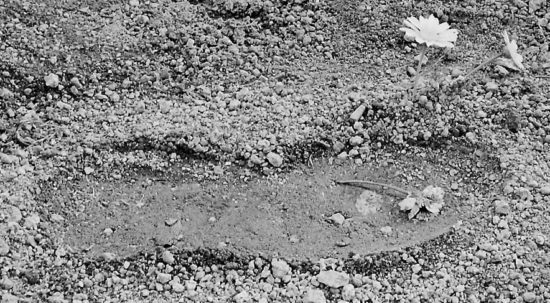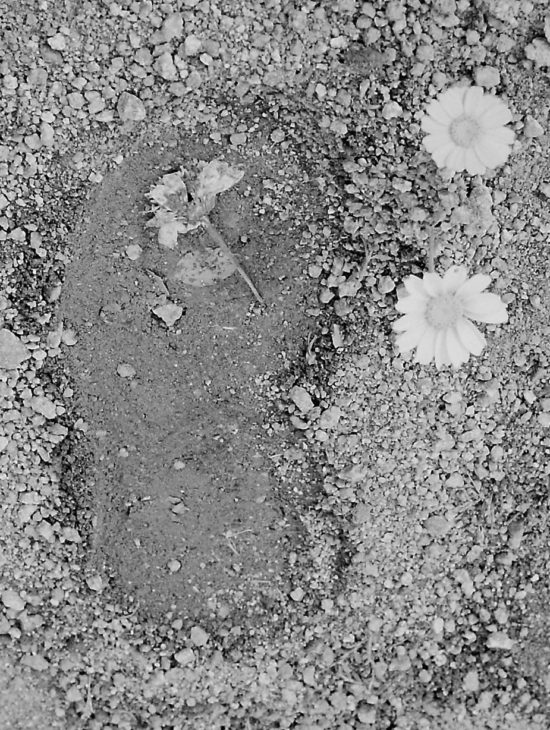As a San Fernando Valley resident at the time and far removed from the greater LA basin, it’s rather ironic how I came to experience what I did on April 29, 1992, and where; roughly a 4.5 mile straight line to the riot’s epicenter at Florence and Normandie. I was a student at Pierce College in Woodland Hills at the time and a photography class assignment to illustrate the theme of “Man’s Impact On His Environment” (speaking of ironic) was coming due. On the early afternoon of April 29 I got on my motorcycle from my home in Sherman Oaks and rode to Baldwin Hills with the idea of photographing the oil derricks pumping there along the hills and ridge lines. Dissatisfied with the compositions I found I ended up at serene oasis that is nearby Kenneth Hahn State Recreational Area at one of the horseshoe pits, taking set-up shots of my shoe print and a crushed flower in the dirt.
While I was doing this a woman came over, sat on the backstop of the pit and watched me for a few moments until she finally asked me if I’d “heard the news?” I stopped and shook my head. “They were found not guilty,” she said and I knew instantly she was referring to the officers on trial for the beating of Rodney King. I expressed my incredulity and then promptly went back to taking pictures of my shoe print. She waited a few more moments before standing up. “I don’t think you understand,” she said, and I looked back up at her. “I’m getting out of here.” I stared blankly. “And I’m black,” she finished, and started walking purposefully toward the parking lot.

Finally and fully I comprehended what she was trying to get through my thick white head, and when I did I offered up an emphatic “Thank you!” wished her good luck and wasted not another second getting back to my motorcycle at which time a pick-up truck drove slowly past me, stopping a few spaces down. In the cab were two young black men with two more riding in the bed and all were staring at me with a fury the likes of which I will never forget. There was no mistaking their rage and that it was focused directly at me and the color of my skin. Fortunately — no: miraculously — parked farther down past them at the end of the lot was a black-and-white — not LAPD but rather a “Safety” police vehicle, whatever that meant. I couldn’t see if there was an officer inside, but its presence made the four men hesitate enough looking from it back to me and back to it to give me enough time to get my helmet on and my motorcycle started and like a bat outta hell I was northbound on La Cienega and gunning the throttle.
By the time I got to the bottom of the hill, the Fedco at Rodeo and La Cienega (now it’s a Target) was already on fire and being looted, and I split the gridlocked lanes between cars many of whose drivers looked terrified stuck there in the gridlock as if a tsumani was bearing toward them from the rear and they had no escape.
When I got home to the relative calm of the valley I turned on the television and the Los Angeles I had earlier been in the middle of had turned into a living burning hell. I locked the doors, loaded the gun, and stayed glued to the newscasts broadcasting the horror and the heartbreak of a city seemingly hell bent on burning itself down.
I watched the endless replays of the attack on Reginald Denny, and who’s to say what might have happened to me if that woman hadn’t warned me or that police vehicle hadn’t been there, but I’m thankful either way I didn’t have to find out.
Days later after the chaos had been quelled and a certain order had been restored, I was in the dark room at Pierce College developing images from those few frames I snapped for the photo class assignment (I believe I got a C grade for the passable quality of the photos as shown with comments that I took the assignment too literally), and it dawned on me that the image’s subject matter was something I could have easily recreated in the comparative safety of my own backyard instead of in the midst of the waves of rioting that flooded the city.


 Follow
Follow